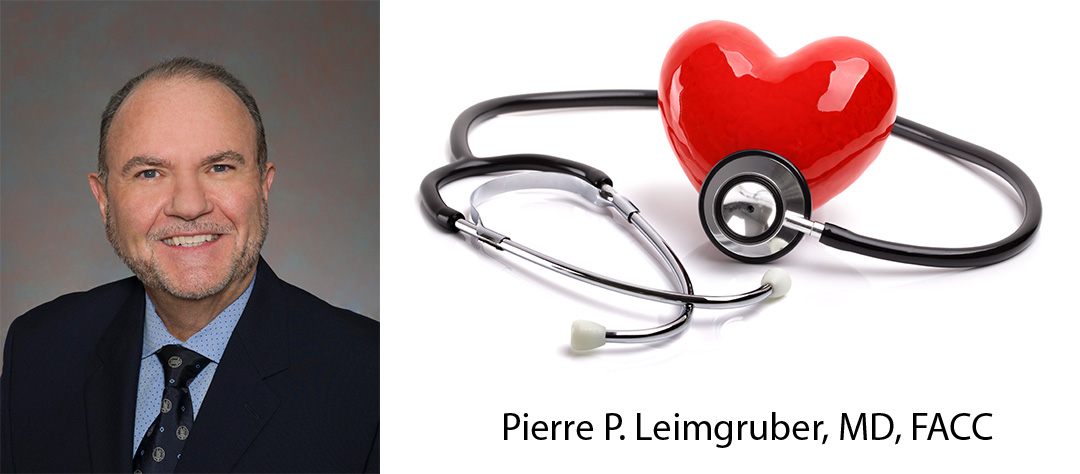Pierre P. Leimgruber, MD, FACC will be bringing a unique personal and professional passion for coronary artery disease (CAD) prevention to the Heart Attack & Stroke Prevention Center when he joins my practice, starting on April 3. Previously, he worked for 32 years as an interventional cardiologist.
Not only has Dr. Leimgruber witnessed the devastating effects advanced CAD can have (he’s performed thousands of balloon angioplasties and stent placements to reopen severely clogged heart arteries), but he has also battled the disease himself. That’s given him a special empathy with his patients. Here’s a look at his heart-disease journey–and some insights gained.
A Shocking Diagnosis
“It was quite a shocker to be diagnosed with coronary artery disease (CAD) in 1996, even though I was already taking cholesterol medication to reduce my risk,” says Dr. Leimgruber, who turned out to have such severe arterial blockages that he needed triple-bypass surgery at age 45.
Like many patients at the HASPC, Dr. Leimgruber has a family history of CAD, also known as heart disease or cardiovascular disease. “I have a very bad genetic predisposition: Both of my parents and one of my brothers died from CAD at a relatively young age.” Despite following a heart-healthy lifestyle, he adds, “I couldn’t escape my genetic risk.”
After the surgery, he soon returned to his busy medical practice and clinical research. He has served as Local Principal/Co-investigator of dozens of clinical trials and has presented his findings at annual meetings of the American Heart Association and other medical specialty groups. His research studies have been published in Circulation, American Journal of Cardiology, American Heart Journal, The Lancet, New England Journal of Medicine and other leading medical journals.
Can Heart Attacks and Strokes Be Prevented?
“During the years that I was treating people who had advanced coronary artery disease–there was so much plaque in their arteries that they were either on the brink of having a heart attack or had already had one–I’d often think, ‘What if there was a way to successfully intervene 10 or even 15 years earlier? Could we actually prevent heart attacks and strokes, instead of doing multiple procedures inside the arteries of the same patients as their disease continues to progress?’”
While practicing interventional cardiology in Spokane, where he was affiliated with four leading hospitals, Dr. Leimgruber heard about the Bale Doneen Method. In 2011, he became a patient at the HASPC. “I was impressed with how Dr. Amy Doneen keeps up with the most up-to-date scientific knowledge and applies it to the individual patient to focus on prevention at the earliest possible stage.”
The Heart Attack Gene
Tests confirmed that genetics is one of the root causes of Dr. Leimgruber’s CAD: Like about 50% of Americans, he is a carrier of the 9P21 gene, which is often called “the heart attack gene” because it’s an independent predictor of cardiovascular risk even when such factors as obesity, high blood pressure, diabetes and inflammation are taken into account.
As discussed more fully in my book, Beat the Heart Attack Gene, carriers of the 9P21 gene are up to four times as likely to develop CAD, often at a young age, and up to twice as likely to suffer a heart attack, as those without the 9P21 gene. However, DNA doesn’t have to be destiny, since those with the gene can still avoid a heart attack by managing their risks with proven prevention strategies and optimizing their lifestyle.
Our comprehensive testing also identified other factors that played a role in his heart disease, including previously undiagnosed insulin resistance (the root cause of about 70% of heart attacks and almost all cases of type 2 diabetes). Results from his genetic tests also provided guidance on developing a diet based on his DNA and led to adjustments in his medication.
From Intervention to Prevention
“Now that I’ve seen first-hand how successful the Bale Doneen Method is, I decided to change my focus from intervention to prevention,” reports Dr. Leimgruber, who also serves as Clinical Associate Professor of Medicine at University of Washington School of Medicine in Seattle. He received his medical degree from University of Zurich Medical School in Switzerland and trained with Andreas Gruentzig, MD, the inventor of balloon angioplasty, at Emory University Hospital in Atlanta, Georgia.
“Having been both an interventional cardiologist and a patient with CAD myself, what I can bring to Amy Doneen’s practice is a powerful commitment to using the Bale Doneen Method to help people avoid the stents and angioplasties that used to be my specialty,” says Dr. Leimgruber, who is board-certified in internal medicine, cardiovascular diseases, and interventional cardiology.
“If caught early, and treated with evidence-based therapies–including optimal lifestyle–this disease is beatable, even if you have a strong family history of CAD, as I do,” adds the doctor, who is also a graduate of the Bale Doneen Preceptorship Course for healthcare providers.
